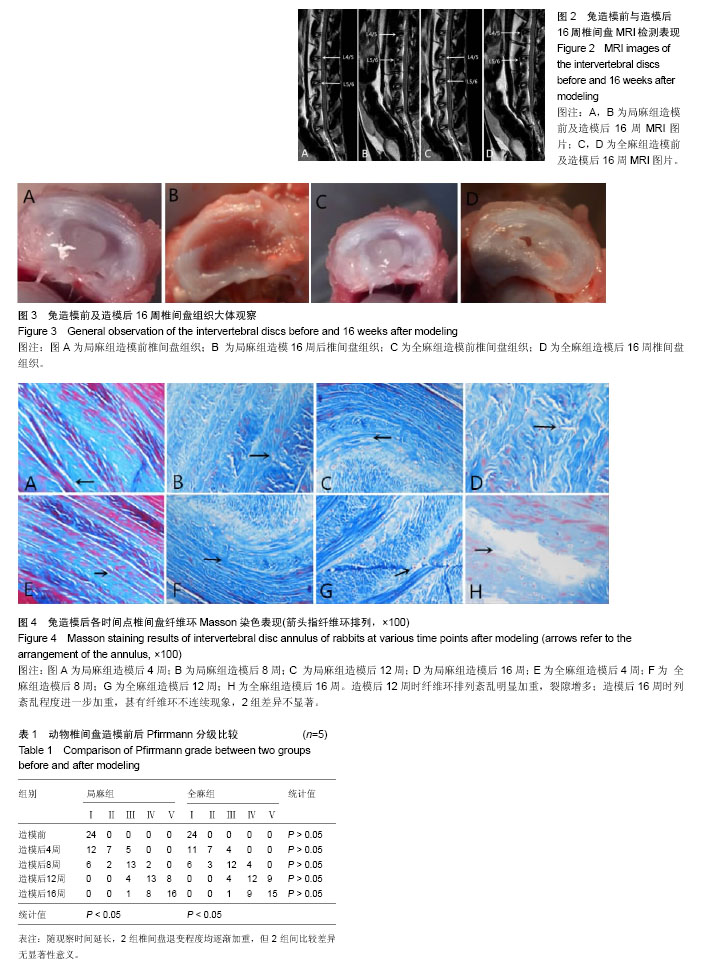| [1] Wang F, Cai F, Shi R, et al.Aging and age related stresses: a senescence mechanism of intervertebral disc degeneration. BioMed Res Intern.2016;24(3):398-408.[2] Vergroesen PP, Kingma I, Emanuel KS, et al. Mechanics and biology in intervertebral disc degeneration: a vicious circle. Osteoarthritis Cartilage.2015;23(7):1057-1070.[3] 郑杨,赵凯,朱科林,等.自制穿刺针闭合穿刺建立兔腰椎间盘退变模型[J].中华实验外科杂志,2015,32(7):1759.[4] 韦文姜,郭文波,吴志强,等.兔纤维环穿刺及终板下椎骨缺血诱导下椎间盘退变模型的建立[J].影像诊断与介入放射学.2014, 23(4):283-287.[5] 王鹏,徐海孺,骆国钢,等.经皮穿刺纤维环法诱导兔腰椎间盘退变模型[J].浙江中西医结合杂志,2009,19(11):668-670.[6] 王靖,唐天驷,姚啸生,等.纤维环穿刺诱导椎间盘退变动物模型的实验研究[J].中国脊柱脊髓杂志,2006,16(4):284-287,Ⅰ.[7] 崔运能,李绍林,周荣平,等.CT引导下经皮纤维环穿刺建立兔腰椎间盘退变模型[J].中国脊柱脊髓杂志.2014,24(3): 234-243.[8] 吴志强,周利君,陈江波,等.经皮穿刺纤维环建立大鼠椎间盘源性疼痛模型[J].中国组织工程研究,2015,19(18):2831-2837.[9] 贺庆,李兵,卓祥龙,等.经皮纤维环穿刺与经肌间隙纤维环刀刺建立兔椎间盘退变模型[J].中国组织工程研究[J].2014,18(13): 2059-2064.[10] 尤国兴,王瑛,王波,等.麻醉方法对大鼠生理、血气及血液流变学的影响[J].中国输血杂志,2013,(5):417-420.[11] 卢庭婷,汤小军.不同麻醉方法对大鼠生理、血气及血液流变学指标的影响.海南医学院学报[J].2015,(4):464-466+469.[12] Daly C, Ghosh P, Jenkin G, et al.A Review of Animal Models of Intervertebral Disc Degeneration: Pathophysiology, Regeneration, and Translation to the Clinic.Biomed Res Int. 2016;2016:5952165.[13] 巴穆登,艾尔肯?阿木冬,孟祥玉.如何构建能较全面模拟人类椎间盘退变性疾病的椎间盘退变实验动物模型[J].中国组织工程研究,2015,19(18):2940-2946.[14] Gullbrand SE, Malhotra NR, Schaer TP, et al.A large animal model that recapitulates the spectrum of human intervertebral disc degeneration.Osteoarthritis Cartilage. 2017;25(1): 146-156.[15] Lotz JC, Ulrich JA.Innervation, inflammation, and hypermobility may characterize pathologic disc degeneration: review of animal model data.The Journal of bone and joint surgery American volume.2006;88 Suppl 2:76-82.[16] 康然,黄桂成,李海声,等.纤维环切开法建立猪腰椎间盘退变动物模型[J].实用老年医学.2012,2(2):141-145.[17] 王海莹,张旭,丁文元,等.椎间盘退变动物模型的研究进展[J].中国脊柱脊髓杂志,2015,25(3):279-282.[18] 孔杰,王子轩,季爱玉,等.应用微创技术建立恒河猴腰椎间盘早期退变模型[J].中华外科杂志,2008,46(11):835-838.[19] 彭俊, 徐建广.犬椎间盘经皮针刺退变模型的建立[J].中国组织工程研究.2012,16(24):4463-1166.[20] 黄杰烽,郑杨,夏臣杰,等.经皮穿刺纤维环建立兔腰椎间盘退变模型[J].临床骨科杂志,2016,19(2):235-239.[21] Zalucki O, van Swinderen B.What is unconsciousness in a fly or a worm? A review of general anesthesia in different animal models.Consciousness and cognition.2016;44:72-88.[22] Vanhove C, Bankstahl JP, Kramer SD, et al.Accurate molecular imaging of small animals taking into account animal models, handling, anaesthesia, quality control and imaging system performance.EJNMMI physics.2015;2(1):31.[23] 杨润生.动物麻醉法浅述[J].实验科学与技术.2009,7(4):41,94.[24] Jalde FC, Jalde F, Sackey PV, et al.Neurally adjusted ventilatory assist feasibility during anaesthesia: A randomised crossover study of two anaesthetics in a large animal model. Eur J Anaesthesiol. 2016;33(4):283-291.[25] 石永芳.动物麻醉方法和麻醉药物研究现状[J].城市建设理论研究:电子版,2015,(16):4638-4639.[26] Dal Molin SZ, Kruel CR, de Fraga RS, et al.Differential protective effects of anaesthesia with sevoflurane or isoflurane: an animal experimental model simulating liver transplantation. Eur J Anaesthesiol. 2014;31(12):695-700.[27] Habre W, Petak F.Anaesthesia management of patients with airway susceptibilities: what have we learnt from animal models? Eur J Anaesthesiol. 2013;30(9):519-28.[28] Tan W, He S, Sun Z,et al. [Etablishment of intervertebral disc degeneration of rabbits by using minimally invasive acupuncture and rotary-cutting].Zhongguo Xiu Fu Chong Jian Wai Ke Za Zhi. 2016;30(3):343-347. [29] Chai JW, Kang HS, Lee JW, et al.Quantitative Analysis of Disc Degeneration Using Axial T2 Mapping in a Percutaneous Annular Puncture Model in Rabbits.Korean J Radiol.2016; 17(1):103-110. [30] Kim DW, Chun HJ, Lee SK.Percutaneous Needle Puncture Technique to Create a Rabbit Model with Traumatic Degenerative Disk Disease.World Neurosurg. 2015;84(2): 438-445. [31] Ren D, Zhang Z, Sun T, et al.Effect of percutaneous nucleoplasty with coblation on phospholipase A2 activity in the intervertebral disks of an animal model of intervertebral disk degeneration: a randomized controlled trial.J Orthop Surg Res. 2015;10:38.[32] Kwon YJ.A minimally invasive rabbit model of progressive and reproducible disc degeneration confirmed by radiology, gene expression, and histology.J Korean Neurosurg Soc. 2013;53(6):323-330. [33] Issy AC, Castania V, Castania M,et al.Experimental model of intervertebral disc degeneration by needle puncture in Wistar rats.Braz J Med Biol Res. 2013;46(3):235-244.[34] Zhou RP, Zhang ZM, Wang L, et al.Establishing a disc degeneration model using computed tomography-guided percutaneous puncture technique in the rabbit.J Surg Res. 2013 ;181(2):e65-74.[35] Han B, Zhu K, Li FC, et al.A simple disc degeneration model induced by percutaneous needle puncture in the rat tail.Spine (Phila Pa 1976). 2008;33(18):1925-1934. |
.jpg)

.jpg)
.jpg)